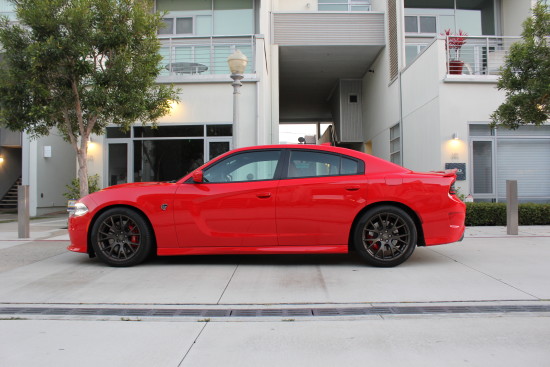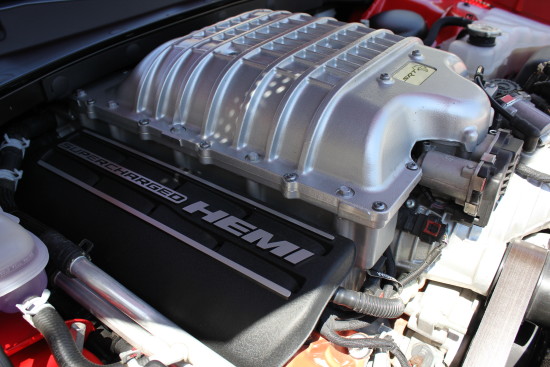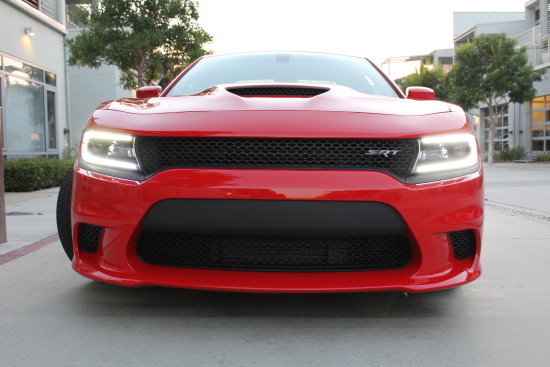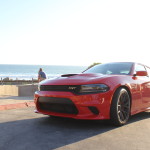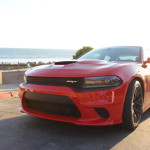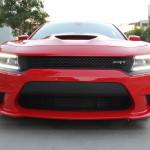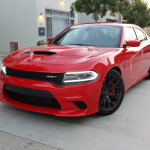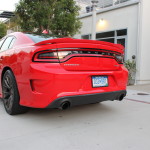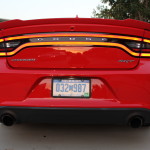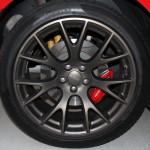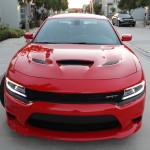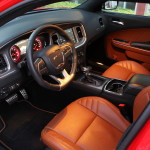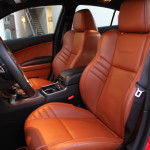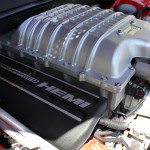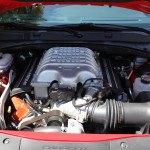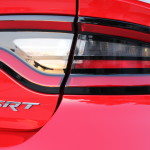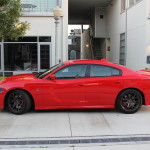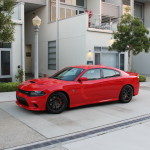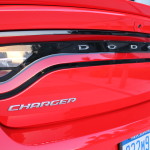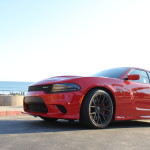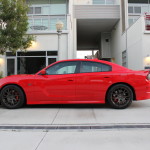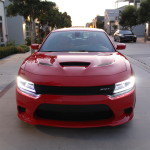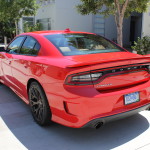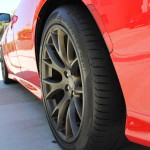Whether you believe 707 horsepower in a rear-wheel drive sedan is a micro experiment of Darwinian evolution, a gift from God, or, just laughable, one fact is undeniable: the Dodge Charger SRT Hellcat is one of the last, and certainly most vivacious, expressions of gas-powered automotive thrills before the dawn of alternative energy vehicles.
As such, the Challenger and Charger Hellcats are a fascinating flare before the boisterous, petrol-guzzling flame goes out. Their supercharged 6.2-liter HEMI V8 engines, snarling bodywork, and mid-$60,000 price tags contribute to a sense of authority, personality, and pride.
The future of performance vehicles will no doubt surpass even the Charger Hellcat’s monumental 0 to 60 mph sprint of 3.5-seconds, it’s 11.2-second quarter mile run, and perhaps even its jaw-loosening 204 mph top speed. But hybrid, hydrogen, and battery-powered electric vehicles will surely lack the presence that is inherent to an earth-quaking HEMI V8 engine.
I consider it an honor to have spent some seat time in one of the purest reflections of brutish power you can buy, but let me be clear: big kitty is not what she seems.
So much more than an engine
Just like the 2013 Ford Mustang GT500, with its 662 horsepower supercharged V8, I had written a review of the 2015 Dodge Charger SRT Hellcat in my mind long before I plopped into the driver’s seat. Frankly, I think everyone who knew of the mid-2000’s Viper’s seemingly untamable desire to murder its owners or anyone who’s taken a ride in a 500+ horsepower muscle car had preconceived notions about what the Hellcats would and wouldn’t be capable of on road and track.
However, after approximately twenty minutes behind the wheel of the Hellcat, I was forced me to wipe my expectation whiteboard clean and start over. The first indicator that I had misjudged the beast was its stopping power. On paper, the large-and-in-charge Brembo six-piston front and four-piston rear brake calipers clamping down on equally robust 15.4- and 13.8-inch front and rear discs are impressive. In reality, they’re better than that. Not only is there tremendous feel through the brake pedal without being overly sensitive, but the way speed is scrubbed off is just fantastic. The nose doesn’t crash to the ground, making the tail feel light and dashing confidence.
Instead, the 4,575-pound super sedan comes to a halt with astounding composure. The Hellcat consistently reels in its surging force without even the slightest twitch of fade – I can’t wait to see how it handles itself on the track.
Related: 2015 Honda Civic Si Review
Yet another surprise is how smoothly the beast drives. It’s impossible to escape the rumble and roar of its supercharged HEMI engine surging up your spine, but it’s not so overwhelming that you don’t notice how quiet the cabin in, especially at cruising speeds. Combined with some of the most comfortable (and thick) sport seats I’ve ever nestled my behind into, the cabin is wonderfully pleasant. It’s more than just some thick glass and well-bolstered seats – just about any convenience or luxury feature you could ask for on a $50,000 or $60,000 sedan is at your fingertips.
Here are some of the Hellcat’s standard features: adaptive damping, keyless ignition and remote start, rear parking assist, back-up camera, blind spot monitoring, a 7.0-inch customizable instrument cluster, heated and ventilated front seats, heated rear seats, heated steering wheel, button-controlled tilt and telescoping steering wheel, dual-zone automatic climate control, 8.4-inch Uconnect infotainment system with voice commands, LED daytime running lights, and automatic headlights.
For an additional $1,995, you’ll get a 19-speaker Harmon Kardon sound system, GPS Navigations, HD Radio, and stickier summer tires. To say the Hellcat is “fully loaded” would not be an embellishment.
Of course, this isn’t a German luxury sedan, and that means you’ll notice a few hard plastic surfaces and a somewhat uninspired dashboard, but it just doesn’t matter when all your primary touch points look and feel sublime, and you’re treated to high quality technology and convenience goodies. Uconnect’s infotainment system is clear and easy to navigate, albeit with a split-second delay to process a command, the two-tone interior (black and saddle on my tester) has plenty of visual intrigue, and the overall fit and finish is perfectly matched with its price point. There’s a reason some dealers have sold these cars at almost 50-percent above their $62,295 sticker price – buyers probably don’t feel horribly swindled when they do the math on deliverables for dollars.
Your daily driver supercar
At no point does the Dodge Charger SRT Hellcat let you forget that it has 707 hp and 650 pound-feet of torque ready to tear your head off. Yes, if you only use the red (full-power-access) key during every outing – like I did – then you’re dancing with the devil, but even with the black key’s “tame” 500 hp, this car is a monster. That being said, it’s a monster with manners, provided proper training.
There are a few ways to make the Hellcat purr. First, there are four driving modes: default, custom, sport, and track. Default keeps the dampers, throttle, and transmission in “street” settings, softening the ride a bit. Custom let’s you arrange driving dynamics according to personal preference. Sport sharpens the throttle, hastens the shifts, and tightens the suspension. Sport also loosens the traction control restrictions a bit. Toggle things over to Track and you’d better be paying attention. Not only is the throttle ready for an ant to crawl on it to go full-bore, but the shifts are lightning-fast, the traction control is taking a nap for the most part, and the suspension is as tightly wound as a….Hellcat?
Oddly enough, the mode I found most useful for puttering about was Eco. Laugh all you want, but when you’re navigating tight streets or parking lots, it’s not a bad idea to have a bit more “give” to the throttle before launching into that old lady crossing the street. Once you’re out of harms way, by all means, notch it over to Sport – that’s what this car’s made for – but it’s a relief to have a mode that is more forgiving of a slip of the foot.
What about the steering? Good news – it’s hydraulic (thank you, Dodge!). In fact, the Charger and Challenger SRT Hellcats are the only vehicles in Dodge’s lineup that still offer hydraulic steering, and what a difference it makes in terms of communication. The weight and feedback is far more enjoyable that electrically-assisted units, regardless of how much artificial intuition a given system has been programmed to deliver.
As for the transmission, it has quite the dual personality. In the more benign driving settings, the TorqueFlite eight-speed automatic shifts smoothly to cruising speeds without any concern that you’ll be completely out of the power band, but in Sport and Track modes, each pull of the paddle is met with the thrust of canon fire. It’s not just the force of acceleration that smashes you against the seat-back, it’s a jarring, near-instant shove from the gearbox. Perhaps some would call the forceful shifts a criticism, but I sensed some giddy Dodge engineers have introduced another touch of theatre to an already dramatic production. The paddles transformed into expressions of authority, and I was happy to assert myself.
Power delivery is comical at times, but you can adapt. Even with launch control engaged, burying the throttle in first gear at 3,500 rpms will simply cloud your rearview mirror with smoke. For the best traction, I paired the softest suspension setting with both the Sport mode’s traction control and Track mode’s transmission shifts before rolling onto the throttle, instead of mashing it out of the hole. This combination keeps tire spin in check and lets the Charger Hellcat achieve 60 mph in 3.5 seconds, according to the on-board data recorder. At speed, if you keep the dial just under 4,000 rpm before leveling your right foot, you’ll access the best of the beast’s thrust every time. Treated with respect, the Charger Hellcat is the best anti-depressant in the world.
Full sensory performance
Future performance vehicles may be faster, more aerodynamic, more efficient, and more practical than the Hellcat, but I can guarantee they’ll lack the ability to deliver thrills that please each of your senses. Is stupendously quick acceleration as giggle-inducing without the roar of a V8? Is spirited driving as thrilling without requiring the skills to keep your car under control? Possibly, but I’d sacrifice numerically-dominant performance for driving pleasure any day. The Charger Hellcat’s stance, sound, and speed combine to satisfy each of your sensory delights.
The term “future classic” refers to new or not-yet-vintage vehicles that have the right formula to attract collectors. On the whole, vehicles are of course terrible investments if your primary goal is to make a significant profit, but the Charger Hellcat strikes me as a creation destined for maturing desire among the automotive community. With the impending death of Dodge’s HEMI V8, the best dollar-to-horsepower ratio available, and the present rarity of the model, even well-loved Charger Hellcats should hold or increase their values over the next several years.
It’s arduous to find fault with a $62,000 sedan that can embarrass supercars in a straight line – both accelerating and braking – corner as flat as the state of Kansas, and treat its occupants to contemporary comfort and technology. But after hundreds of miles behind the wheel, the Dodge Charger SRT Hellcat’s did give up a flaw: tall drivers may notice the sun visor gets in the way sometimes. What a nuisance.
Highs
- Spine-tingling V8 roar
- Incredible and consistent braking
- Man-maker looks
- Premium interior features
- Ravenous power
Lows
- Big kitty is thirsty
- Parking is sometimes a challenge due to its size


